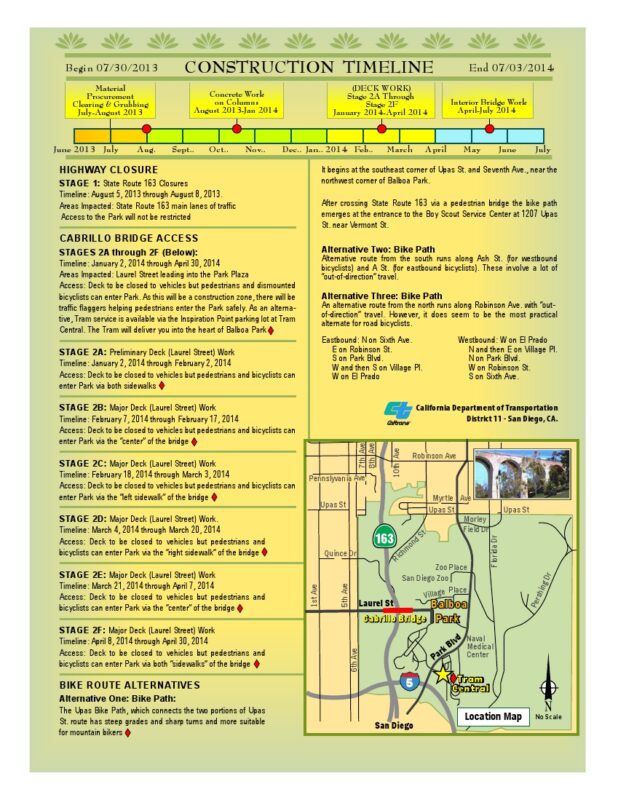City Attorney thinks driving privileges should be revoked...for some chalk protestors
The national and international spotlight was shining strongly on San Diego all of last week and yesterday. Jeff Olson was being prosecuted by the City Attorney for writing Bank of America slogans in water soluble chalk that the bank's representatives didn't appreciate. The case has nothing to do with anything we do here, but I thought it was worth highlighting the two plea offers that Olson rejected in favor of a jury trial. The first plea offer (emphasis mine) was presented as follows:
On May 16, Hazard told Olson the City would drop the case if he agreed to serve 32-hours of community service, attend an 8-hour seminar by the "Corrective Behavior Institute," pay Bank of America $6,299 in restitution for the clean-up, waive all Fourth Amendment rights guarding against search and seizures, and surrender his driver's license for three year period."
The second plea offer made days before the trial was scheduled to begin required Olson surrendering his driver's license for two years:
Olson would plead guilty to one count of vandalism, agree to serve three-years probation, pay restitution --amount undetermined, spend 24-hours cleaning up graffiti, and surrender his driver's license for 2-years.
The jury acquitted Olson of all thirteen counts.
I hope the City Attorney can move with equal tenacity against drivers who cause far more permanent damage on lives of our friends and neighbors who happen to ride a bicycle in a city notoriously unfriendly to those outside the automobile. Unlike chalk, a car-centric city like ours causes much more lasting harm on our well being and quality of life. Driving is a privilege and should be treated as such with penalties meted out in a way that matches the harm caused, unlike the chalk prosecution case that brought much unwanted attention to our city.
Caltrans to begin work on Cabrillo Bridge Retrofit soon; Cabrillo Bridge to be closed to vehicular traffic from January 2014 - April 2014

I guess a car-free Cabrillo Bridge is in your future sooner than you thought.
Seth Cutter, Bicycle and Pedestrian Coordinator at Caltrans sent in an email stating that Caltrans, in conjunction with the City of San Diego, will begin a rehabilitation and seismic retrofit project of the Cabrillo Bridge this summer.
The purpose of this project is to improve the structural integrity of the Cabrillo Bridge but in the process the project will preserve a beautiful, historical and important City icon.
The project will begin in summer of 2013 and end summer of 2014. Some of the traffic road closures on the freeway (State Route 163) will be routine. Laurel Street is the bridge road deck that leads into Balboa Park from 6th Avenue and points west. This deck will be closed to vehicular traffic from January 2014 through April 2014. Work on the roadway/deck surface will be conducted in stages allowing for pedestrians and bicyclists to access the park through clearly-marked passageways either on the right, left or center of the road.
Cutter emphasized that bicycle riders and pedestrians would not be prohibited from using Cabrillo Bridge during the retrofit.
Project Manager Lou Melendez is soliciting input and ideas from the public to make the road closures as convenient as possible for all park visitors and customers. You may reach Melendez by phone at (619) (688-3328) or via email at lou.melendez@dot.ca.gov.
One way to ensure this retrofit gets its full value is to ensure that the bridge remains closed to vehicular traffic once the retrofit is complete. This will ensure that the structural integrity lasts longer than it would with heavy vehicles trundling over an old, narrow bridge into Balboa Park.
Below is more information about the retrofit to begin this summer. Click the images for a bigger version.

Foto Friday: (Re)Designing Cities For Socialization
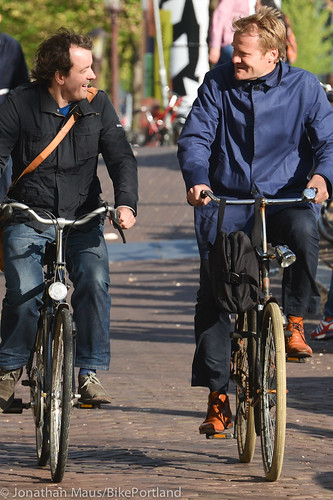
Jonathan Maus was recently in Denmark and The Netherland and had a series of posts documenting his visit. I thought it was worth sharing his thoughts on redesigning a city for socialization.
In great bicycle cities, the quality of the bike network creates a riding environment suited to conversation. In fact, in both Denmark and the Netherlands, bikeways are designed specifically with socializing in mind. In the Netherlands, fostering a healthy "social being" is a core design element. On busy streets, completely segregated cycle tracks are wide enough for side-by-side riding (Copenhagen has some 16-foot wide cycle tracks with "social" lanes (a.k.a. passing lanes)). And on lower volume streets, traffic is so calm it's easy — and quite nice actually — to chat while you ride.
The maneuverability of bicycles is also a factor. In a good bike city, users of bicycles can take their vehicle nearly everywhere. Unlike a car, with its massive physical footprint and public transport, which runs on fixed routes, it's easy to stop a bicycle if something catches your eye or pull over and chat with a friend. Social cycling is also possible here because most people have a fully upright riding position. If you look at some of my photos from the belly up, the subjects look like they could be walking.Another thing that works into the social cycling mix is that people here are extremely skilled at riding. They can have conversations (on the phone or with a friend next to them) while pedaling through a chaotic intersection rife with bumbling tourists, trams, cars, buses, and so on.
These social interactions that cycling makes possible have a profound positive impact on cities. We learned from a Dutch cycling expert today about the concept of "experience as an economic tool." That is, cities with attractive public space are full of people having experiences and those experiences lead to economic activity. And it's not just felt by people who are riding. Cities in the Netherlands with high bike mode shares have vibrant sidewalk cafes with tables and chairs facing right onto the street. The main reason it's so pleasant to sit and talk at places like that is because there are so few cars rumbling by (in Amsterdam, bicycling is the majority mode of travel).
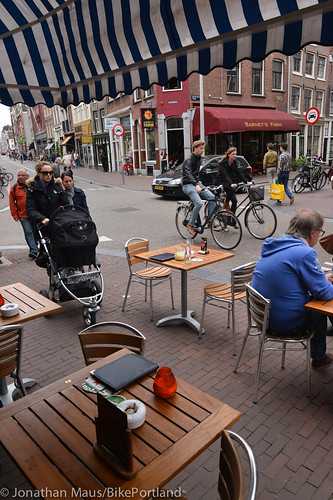
Here in San Diego as we begin to implement quality bike networks with dedicated space for riding on what is currently mostly unpleasant roads, it is important to think about the change not in terms of a loss (such as the loss of parking on public space for private vehicles) but in terms of how much there is to be gained. Sure, a city with its residents riding is good for the environment, for one's health and one's pocket book. But creating space to ride and converse in also makes a city worth living in. And if quality bike networks serve as a conduit to building and strengthening social connections and thus a more robust city, why not build it?
---
I've been a little busy taking care of some personal issues to write updates here. Things will be back to normal next week - Sam.
Salt Lake City: Way Ahead of San Diego
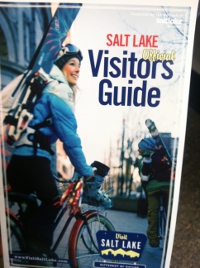
Thanks to an extremely generous scholarship from Streetsblog, I spent a better part of last week in Salt Lake City for the three-day Congress for New Urbanism Conference. Before the conference, I attended a day-long blogger training session with other bloggers and advocates that are covering the livable streets movement all over the country.
This was my first trip to Salt Lake City and having previously paid scant attention to this city, I was in for a series of pleasant surprises from the minute I landed at the airport. During my entire stay, I couldn't help but draw comparisons to how far ahead Salt Lake City is from San Diego, California's second largest city.
Salt Lake City has less than two hundred thousand residents, and yet the city has a light rail line that links the airport to the city's downtown that was not only convenient but a source of pride for the city's residents. Earlier this year, San Diego's mayor Bob Filner called for a trolley link from the city's airport to downtown. But it's going to be a while before we get a trolley system, let alone a light rail. In fact our poor connectivity in transit should be a source of embarassment given the attention we've received in national circles.
Walking from my train stop to my hotel, I noticed how quiet the city was and how pleasant of an environment all the trees along Main Street provided. The sidewalk was amply wide and well maintained and well lit. I somehow doubt that the Stumblr is needed in that city.
The following day, the Streetsblog blogger training featured luminaries such as Aaron Naparstek and Mike Lydon detailing specific
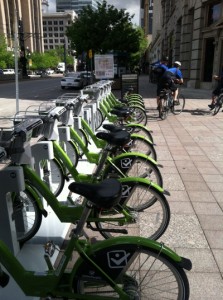
strategies on changing the public debate on what constituted livable cities complete with examples of success. The training was held in Salt Lake City's stunningly beautiful library with unfettered views of the neighboring mountains and cityscape. I couldn't help but notice their library hours - open far more frequently than our own Central library.
After the blogger training, I attended the three day Congress for New Urbanism conference which was very illuminating in learning how the different pieces of a cityscape and governance all fit into one another. There were sessions on community building, on how small changes in one's environment can lead to big behavioral changes, and how desperately people want to connected with one another - something that is a challenge in a car-centric city like ours. I was able to meet and talk with other leaders around the country on how they were effecting change within the private, public and non-profit sectors. Listening to the speakers and my colleagues, I did experience a bit of despair.
Despite living in a city where 93% of trips are made by private motor vehicle, I sometimes forget how far behind we are from other cities around the country and the world. It certainly took less than eleven months for change to happen on Montezuma Road, but so many of our 2,960 miles of roads need some drastic redesigning and change. Besides missing bike infrastructure, our city is gaining publicity for our poorly maintained sidewalks and roads. Many of the conference attendees remarked at how wide Salt Lake City's roads were and I had to stop myself many times from talking about how much wider San Diego's streets were - that wasn't anything worth bragging about. Many of the conference attendees I met were confused on why San Diego was not on the world stage for livability issues. Nearly everyone described our near perfect weather as a reason on why we ought to be on the forefront of the movement. But we're not. We have to catch up to cities as large as New York City, as similar as Los Angeles and Long Beach and as tiny as Salt Lake City.
I am certainly pleased with the leadership that San Diego has demonstrated in recent months. But on my return flight home, I read the news that the Plaza de Panama Committee had appealed the judicial ruling on Balboa Park. This committee had been touting a plan to build a bridge and an 800-space parking garage in the middle of Balboa Park. The committee disagreed with the judicial ruling about the plan which was proposed and promoted as a solution to create a pedestrian free plaza in the middle of the park.
Given how much public space we have handed out and continue to hand out to the automobile at the expense of human life and creating quality public spaces, I was and am embarrassed at how little we had accomplished in comparison with other cities around the country. To paraphrase city traffic engineer, Brian Genovese, there is so much work that needs to be done and done quickly. We cannot as a city afford to tip toe around the automobile that despite decades of funding subsidies and support continues to fail in delivering its purported results while giving a us a black eye on the national and international stage.
To read more coverage about the CNU21 conference and about the the Streetsblog network here are a sampling of a few excellent posts by my colleagues discussing Salt Lake City's bike share program, the language bias inherent in transportation engineering, an interview with Jason Roberts, and recaps of the conference by Steve Mouzon.
Results of BikeSD.org’s Survey - Our Questions and Your Responses
About three weeks ago, we created a survey to gauge your interest in supporting our vision to transform San Diego into the world’s best bike friendly city. The idea for the survey originally came from Stephen Waits during the course of a twitter discussion on how different types riders felt about the riding conditions in San Diego. Waits was instrumental in sending the survey out to a variety of riding groups and individuals. I’d like to thank Waits for taking a lead on distributing the survey. We received 247 responses before the survey closed.
Before I detail the responses from the survey, a couple of details need to be kept in mind. Since we don’t know how many people received and read the original email or saw the writeup, it is difficult to determine what the response rate is. But given that there is no other way of determining what San Diegans want in order to make our city more a world-class bicycling city, given our very limited resources, the survey results is the best we can work with - for now.
The Responses
Question 1: If you had a magic wand to magically fix something about your riding experience, what would that be?
62% of respondents wrote responses that revolved around infrastructure issues. There was a lot of emphasis on wanting protected separation from cars. 19% of respondents wanted something to be done about distracted drivers.
Amongst these responses were also requests for better road conditions asking for everything from pothole fixes to smoother road surfaces.
The remaining responses were all over the place and ranged from wanting more legal enforcement to wanting to be more fit to cover long distances while not experiencing as many flats. While these responses were appreciated I couldn’t categorize them clearly in order to determine a specific point of action.
Here is a sampling of some of the responses on the first question:
Protected bike lanes on Miramar Road and an attitude adjustment for most drivers
Actual bike lanes would be awesome. Some greater sense that I'm not going to get tagged by a car from behind.
Separate roads for cyclists, less noise on my commute.
Safer ways to get around SD on a bike without having to worry about getting run over
Dedicated areas on busy major streets for bike lanes. Not even fenced off lanes, just a line that says "Bikes Only", which got paved like the rest of the surface streets. I'm tired of spending money on tubes because of pot holes.
Dedicated bike lanes separated from the cars by a concrete divider - for all major routes, and some minor ones at least - especially 101 from Oceanside to UCSD.
Bike only paths where no vehicles with automated motors are allowed.
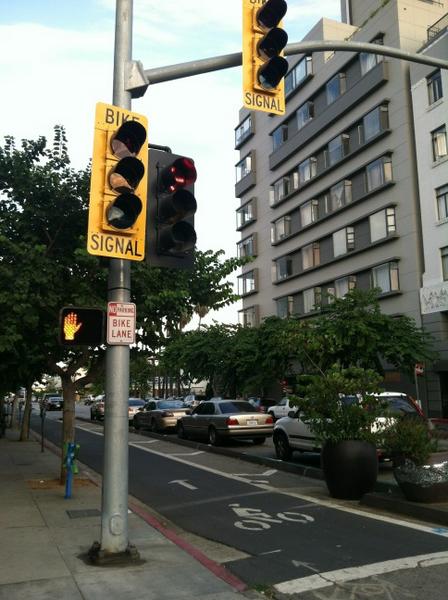
Although San Diego has a handful of bike paths such as the award winning Bayshore Bikeway, calling them a “bike” path is a misnomer since these are actually multi-use paths and open to everyone including dog walkers, joggers, parents with strollers and our homeless population wanting a bit of respite from elsewhere. So while these bike paths are a very good starting point for recreational riding or for children to ride on while practicing their balancing skills, they aren’t as effective as a transportation corridor. After having ridden on cycletracks in both Copenhagen and Long Beach, CA, I've realized that cycletracks are the key type of infrastructure that will both offer the protection that riders and wannabe riders are asking for. This will also ensure a better allocation of the public space to ensure traffic throughput as the city grows to accommodate a larger population.
The other key group that responded to the survey were mountain bikers who felt left out of advocacy efforts and the decision making process. Like the road cycling crowd, mountain bikers wanted safe spaces to enjoy the outdoors and offered a variety of really good solutions. In light of these responses, I’ve connected with Rod Simmons, the President of the San Diego Mountain Biking Association, to strategize on how we can work on advocacy efforts together. During this past year, I’ve learned about the tremendous value that mountain bike enthusiasts provide which include trail maintenance and preserving our incredibly vast open spaces. While I am mostly unfamiliar with the issues that mountain bikers deal with, I’m open to learning and working with them.
Question 2
How much do you think the mayor influences transportation issues in the City?
This question was posed because BikeSD.org is currently a corporation in formation. The organization will be incorporated as a 501(c)(4). The key difference is that a (c)(4) will be able to endorse candidates and be more involved and engaged in the political process. The strategy is modeled largely on the San Francisco Bicycle Coalition which is currently one of the most effective bike advocacy groups in the country representing one out of sixty San Franciscans. Like the SFBC’s (c)(4) that partners with the SFBC’s (c)(3) arm, BikeSD.org will also be partners with the San Diego County Bicycle Coalition, a 501(c)(3) organization.
Question #2 broke down as follows:
Not at all – 7.3%
A little – 25.3%
Somewhat – 29.0%
More than a little bit – 24.1%
A lot – 14.3%
The mayor is the most visible and top elected official in the City of San Diego. Partnering with the Mayor and supporting the mayor’s efforts to implement a vision that considers the needs of bicycle riders will be instrumental if San Diego has any hope of becoming a bicycle friendly city.
Question 3:
Would you be willing to vote in a mayor who promises to invest time, energy and funds with a detailed timeline toward making your riding experience better?
93% of respondents stated that they would vote in such a mayor.
Question 4:
This question was posed to the respondents who answered “no” to Question 3 which stated:
If no, what would convince you to vote in such a mayor?
12 people (33%) stated that they were not single issue voters. Others elaborated to stated that they wanted to see the mayoral candidate demonstrate a history of pushing for bike interests and not simply pandering to get a vote. A handful wanted the candidates to ride on some roads that are notorious for their riding conditions such as Rancho Bernardo Road or Camino Del Norte before offering to vote them in.
Question 5:
Do you believe that San Diego has the potential to be the world’s best city for bicycling?
Despite not being listed anywhere in Bicycling Magazine’s list of top 50 bike friendly cities, we believe that San Diego has tremendous potential to be one of the world’s best cities for bicycling. 80.5% of respondents agreed with us on this issue.
Question 6:
If yes (on question #5), what do you think that would take?
The responses were similar to the ones from question #1 but many respondents elaborated further by stating that San Diego had the ideal weather but needed safer bike infrastructure, political activism, an open discussion about land use issues, support and political will from City Hall and the mayor.
Question 7:
If no (on question #6), why do you think that?
The responses listed everything from San Diego’s car-centric culture to a public lack of faith in the local government or our elected officials. Only 6 out of 54 respondents listed that the hills were a problem.
Question 8:
Which club/riding group are you affiliated with?
We had a lot of responses (25%) from the Triathlete Club of San Diego which was noteworthy given triathlons’ growing popularity. There were many respondents from various racing clubs including Skyflash Racing (25%), Swami’s (11%), Adams Ave (6%). Everyone else was split between mountain biking groups, other informal groups.
Question 9:
How old are you?
18 – 29 - 13% of respondents
30 – 35 – 17.8% of respondents
35 – 45 – 25.1% of respondents
45 - 60 - 36.4% of respondents
61 – 75 – 7.3% of respondents
75+ - 0.4% of respondents
Question 10:
As BikeSD gears up for an official launch, we wanted to know the likelihood of riders paying for a membership and wanted to know what sort of benefits riders expected besides direction action advocacy. The question was:
BikeSD.org will be a member based organization. What sort of member benefits would convince you to join?
The vast majority of respondents wanted to attend events, mixers, organized rides, and be part of an advocacy organization willing to engage with the political process and provide real deliverable advocacy results in the form of change to our transportation network that would transform San Diego into the world’s best city for bicycling.
Given how the results panned out, the goal is to craft a one year set of goals based on your responses in order to garner some real wins that would make bicycling in San Diego a truly pleasurable experience. These goals will be posted here in an effort to be extremely transparent in our work. There is a lot of work to be done and the road ahead is going to be an extremely fruitful one.

